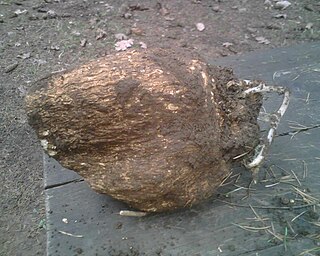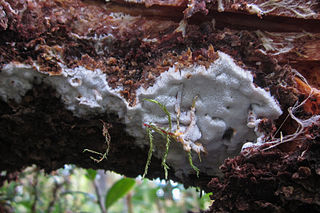
The Polyporaceae are a family of poroid fungi belonging to the Basidiomycota. The flesh of their fruit bodies varies from soft to very tough. Most members of this family have their hymenium in vertical pores on the underside of the caps, but some of them have gills or gill-like structures. Many species are brackets, but others have a definite stipe – for example, Polyporus badius.

Wolfiporia is a genus of fungi in the family Polyporaceae. The genus was circumscribed by Leif Ryvarden and Robert Lee Gilbertson in 1984 to contain the type species Wolfiporia cocos and W. dilatohypha. The genus is named in honor of mycologist Frederick Adolph Wolf, who was the first to officially describe the type species.

Skeletocutis is a genus of about 40 species of poroid fungi in the family Polyporaceae. The genus has a cosmopolitan distribution, although most species are found in the Northern Hemisphere. It causes a white rot in a diverse array of woody substrates, and the fruit bodies grow as a crust on the surface of the decaying wood. Sometimes the edges of the crust are turned outward to form rudimentary bracket-like caps.
Skeletocutis alutacea is a species of poroid fungus in the family Polyporaceae. It was described as new to science in 1946 by American mycologist Josiah Lincoln Lowe as Poria alutacea. Jean Keller transferred it to the genus Skeletocutis in 1979. It is found in the United States and Canada, in Europe, and New Zealand, where it causes a white rot in various woody substrates.
Skeletocutis bambusicola is a species of poroid crust fungus in the family Polyporaceae. It was described as new to science in 2012 by mycologists Li-Wei Zhou and Wen-Min Qin. It is found in southern China, where it grows on dead bamboo. The type collection was made in Mengla County, Yunnan Province. The specific epithet bambusicola refers to its growth on bamboo. At the time of publication, S. bambusicola was the 22nd Skeletocutis species recorded from China.
Skeletocutis bicolor is a species of poroid crust fungus in the family Polyporaceae. It is found in Singapore.
Skeletocutis brunneomarginata is a species of poroid crust fungus in the family Polyporaceae. Found in the United States, it was described as new to science in 2007 by Norwegian mycologist Leif Ryvarden. He collected the type in Bent Creek Experimental Forest, North Carolina in 2004. The fungus is very similar in appearance to Skeletocutis kühneri, but with a brown margin and subiculum. S. brunneomarginata is one of 14 Skeletocutis species that occurs in North America.

Skeletocutis chrysella is a species of poroid crust fungus in the family Polyporaceae. Found primarily in Northern Europe, it has a boreal distribution, and has also been collected in East Karelia, Yakutia, and North America. It is classified as a vulnerable species on the Norwegian Red list, where it is considered to be declining.
Skeletocutis biguttulata is a species of poroid fungus in the family Polyporaceae. It was first described scientifically by Swedish mycologist Lars Romell in 1932. Tuomo Niemelä redescribed and illustrated the fungus in 1998, and explained that collections of this fungus had previously been attributed to the related Skeletocutis subincarnata. S. biguttulata may be distinguished from the latter fungus by its biguttulate spores, more regularly arranged pores, and the cracking pore surface seen in older specimens.
Skeletocutis albocremea is a species of poroid fungus in the family Polyporaceae. It was described as new to science by Alix David in 1982. It was reported as new to Russia in 2004.

Skeletocutis carneogrisea is a species of poroid crust fungus in the family Polyporaceae. It was described as new to science by Alix David in 1982. It is found in Europe, South America, and China.
Skeletocutis diluta is a species of poroid crust fungus in the family Polyporaceae. It was first described by Mario Rajchenberg in 1983 as a variety of Skeletocutis nivea. Rajchenberg and Alex David promoted the taxon to independent species status in 1992. The type specimen was collected in Puerto Esperanza, Misiones (Argentina), where it was found growing on Pinus taeda logs in a subtropical forest. It has since been found in Gabon. Skeletocutis diluta has effused-reflexed fruit bodies, meaning they are crust-like with a margin that is extended and bent backwards. It has small allantoid (sausage-shaped) spores measuring 3.1–3.5 by 0.5–0.8 μm. It features a dimitic hyphal system, but the skeletal hyphae dissolve in solution of potassium hydroxide.
Skeletocutis niveicolor is a species of poroid crust fungus in the family Polyporaceae. It was first described in 1920 by American mycologist William Alphonso Murrill as Poria niveicolor. The type was collected on well-rotted wood found in Cockpit Country, Jamaica in 1909. Leif Ryvarden transferred it to the genus Skeletocutis in 1985. He noted that it was readily distinguished from other Skeletocutis species by its small spores, which measure 2.5–3.1 by 1.5–2 μm. In addition to Jamaica, the fungus has been also reported from Argentina and Costa Rica.
Skeletocutis nothofagi is a rare species of poroid crust fungus in the family Polyporaceae that is found in South America. It has been proposed for inclusion in the IUCN Red List of Threatened Species due to its highly restricted distribution and rare occurrence.
Skeletocutis friata is a rare species of poroid crust fungus in the family Polyporaceae. Found in Finland, it was first described as a new species in 1998 by Tuomo Niemelä and Reima Saarenoksa, with the name Skeletocutis friabilis. It was given the epithet friata three years later, after it was discovered that a tropical Asian species had already been given the name Skeletocutis friabilis, with a publication date two months prior to theirs. The holotype was collected by Saarenoksa in Sipoo, southern Finland, where it was found growing on the bark and exposed wood of a fallen twig of common alder. The authors later noted that subsequent searching of the type locality, as well as other locations in southern Finland, failed to turn up additional examples of this species.
Skeletocutis papyracea is a species of poroid crust fungus in the family Polyporaceae. It was described as new to science by Alix David in 1982. The type was collected in France, where it was found growing on a fallen trunk of Scots pine. The fungus was reported in northeastern China in 2005, and in Lithuania in 2013. A microscope is useful for identification of this fungus: it differs from other Skeletocutis by the fact that its skeletal hyphae dissolve in 5% KOH solution.

Skeletocutis kuehneri is a species of poroid crust fungus in the family Polyporaceae. It was described as new to science by Alix David in 1982. The holotype was collected in France, where it was found growing on pine. It has been recorded from Norway, Finland, and Sweden, although it is rare in the Nordic countries. The fungus is a successor species, and prefers growing on pine that has been previously degraded by Trichaptum fungi, particularly T. abietinum.
Skeletocutis stramentica is a species of poroid fungus in the family Polyporaceae that is found in New Zealand.
Skeletocutis falsipileata is a species of poroid crust fungus in the family Polyporaceae. Found in Malaysia, it was first described by E.J.H. Corner in 1992 as a species of Tyromyces. Tsutomu Hattori transferred it to Skeletocutis in 2002.

Skeletocutis stellae is a species of fungus belonging to the family Polyporaceae.







